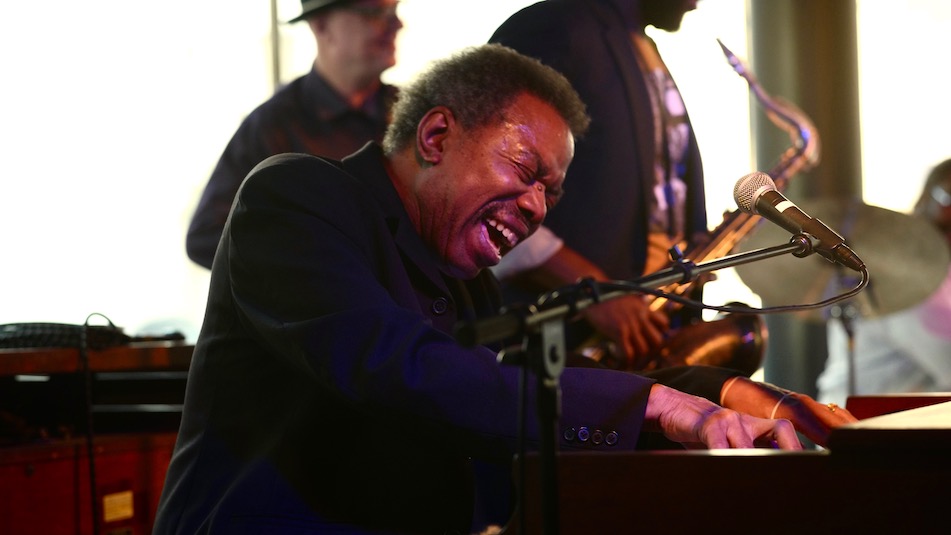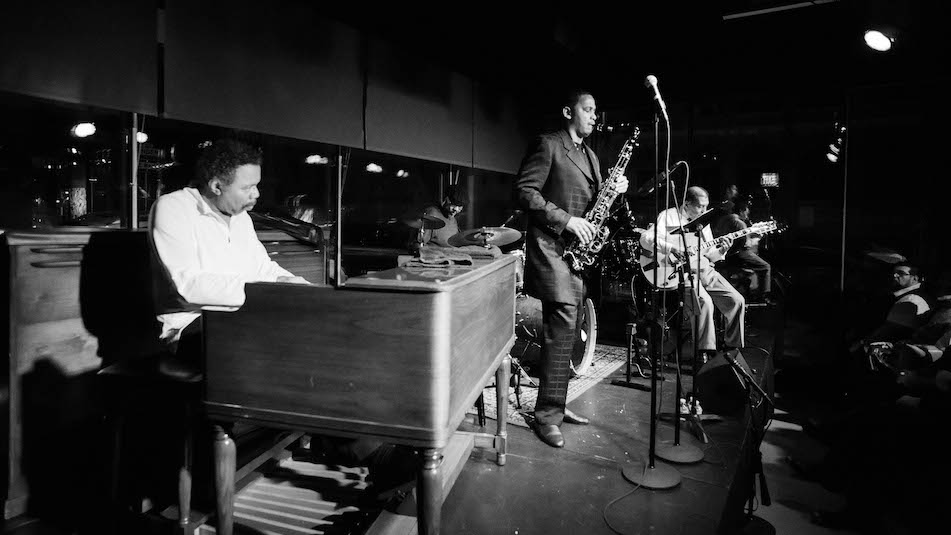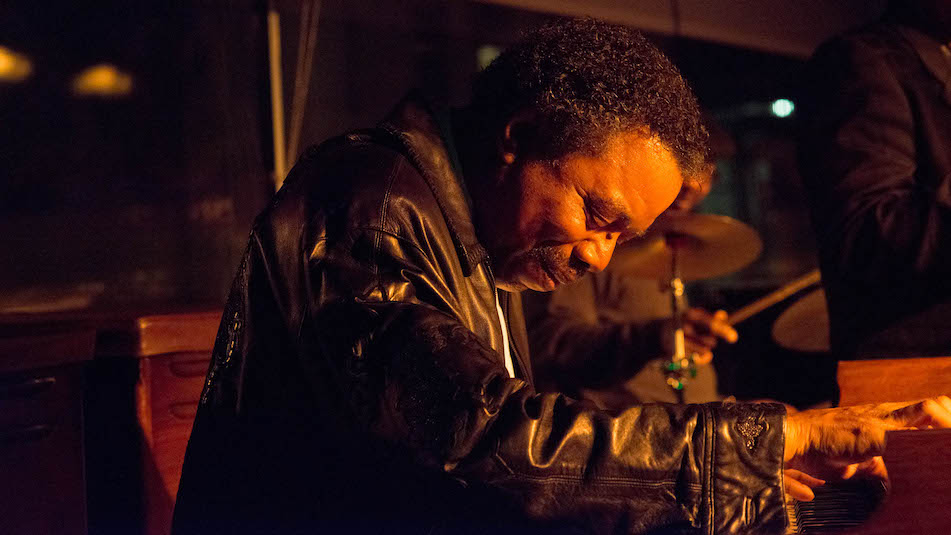Chester Thompson:
Staying Hungry
November 19, 2021 | by Richard Scheinin

Chester Thompson in the Joe Henderson Lab at SFJAZZ, 9/29/19. (photo by Howard Zisser)
Luckily, someone caught it on videotape: Hammond B-3 organist Chester Thompson eating up “Oye Como Va” with Santana in 2002. Thompson builds his solo like a sermon. He starts out casually, noodling some bebop runs on his Yamaha keyboard, but figures… nah. He drops his hands to the B-3, runs a finger straight up the white keys to a high C — boing!!! — and just holds down the note. His eyes look like they’re going to pop out as he uncorks the power of “the machine” — his name for the B-3, a 425-pound behemoth that he’s played for decades, making it preach and plead and reverberate inside a listener’s bones.
Thompson, who played with Santana for 26 years, doesn’t overdo it. He settles back down and toys with the groove. He plays with patterns, shifting the rhythmic emphases, incrementally building tension. He quotes from John Coltrane’s “A Love Supreme.” He juices blue notes — flat 5s, flat 9s — and dances around the tune’s basic harmonies, like a jazz musician, which he is at heart. And then his solo reaches its pinnacle. Once again, he leaps to that high C and just leans into it. Thompson believes that less is more, and right now he is just wailing on that one note. The band is locked in; they are performing for tens of thousands of fans in a stadium in Nuremberg, Germany. But by the look on Thompson’s face, he is, at this moment, unaware of his surroundings. He looks tranced out, as if immersed in a fundamental feeling, as if he’s coming home.
Chester Thompson with Santana at Rock im Park, Germany, 2002. (solo starts at 4:17)
Thompson — who performs Nov. 26 with his soul-jazz quartet at SFJAZZ in San Francisco — grew up playing in church, and it’s the church that wins out in his solo on “Oye Como Va.” It’s his home sound, the sound that touched him as a boy in Oklahoma City, where at around age 10, he began accompanying the youth choir on piano at New Hope Baptist Church.
When he was 16, the minister of music, Minnie V. Anderson, helped him switch to the organ, showing him how to tap out bass lines on the instrument’s long rack of foot pedals — a rocking heel-toe maneuver that would become the basis of Thompson’s funky, double-stuttering bass-line style. It made him a standout during his decade with Tower of Power (1973-83) and his more than quarter-century with Santana (1983-2009). But most importantly, Thompson says, Anderson gave him “the opportunity to play with people who didn’t have a clue about a musical note, but just felt something. And it’s got me to where I am today. She gave me a really good gift. When I was 10 years old, playing for the choir — there must be a thousand people out there. And I don’t ever remember nerves. Because I enjoyed playing and knowing that the music would come from me. And I enjoyed that more than a lot of other things.”
Thompson, 76, pauses. “You’re digging into some memory,” he says with a chuckle. “I’m surprised that I get this kind of attention today. It wasn’t my plan. I just wanted to play. And I guess I still have that in me. It gives you, I guess I could say, hunger.”
At SFJAZZ, Thompson — who has lived in the Bay Area since the late ‘60s — will lead a group of veterans who understand his sound: saxophonist Howard Wiley, guitarist Drew Zingg (known for his work with Steely Dan and Boz Scaggs), and drummer Darrell Green. Thompson expects to play some tunes from his own albums, including Powerhouse from 1971, recorded for the Oakland-based Black Jazz label, and Mixology, a 2011 recording on which he interprets classic compositions by Wayne Shorter and Larry Young, among others.

Chester Thompson performing with saxophonist Robert Stewart, guitarist Calvin Keys,
and drummer Ron E. Beck in the Joe Henderson Lab at SFJAZZ, 12/12/13. (photo by James Knox)
He also plans to perform several tunes from saxophonist Lou Donaldson’s 1961 album “Gravy Train,” a down-home recording with a title that conjures a Thanksgiving meal with all the trimmings. And he figures he won’t leave the hall without playing his funky “Squib Cakes,” which he composed for Tower of Power’s seminal Back to Oakland album in 1974.
It became one of the band’s signature numbers and remains a perfect vehicle for Thompson’s “very assertive, almost aggressive sound,” says Pete Fallico, the KCSM jazz radio personality and B-3 historian who has known Thompson for decades. “Chester’s a master, especially on an up-tempo funk groove where he can show his prowess on the pedals. It distinguishes his playing.” Uniquely, Thompson strives to match every note he plays with his left hand with the same note on his foot pedals. “He’s a virtuoso of the pedals. He gets that rocking bass effect. Just listen to `Squib Cakes’ and you’ll hear what he’s all about.”
Chester Thompson performs "Squib Cakes" at the 2011 Jazz Organ Fellowship concert
Oklahoma isn’t mentioned in most jazz history books. But it’s where a slew of jazz musicians — from Jimmy Rushing to Don Byas and Don Cherry — got their start.
Thompson was born in Oklahoma City in 1945. When he was seven or so, his father bought him “an old upright piano that had a big bass sound and I played that thing until there was no white plastic on the keys anymore. It was never a chore for me to play. My parents didn’t have to have practice time and all of that. I played all the time. Their thing was to stop me.”
The young pianist began listening to jazz at age 13, enraptured by Ahmad Jamal. After his conversion to the organ at 16, he fell under the spell of B-3 organist Jimmy Smith: “I never heard anything like that; just one guy doing it? It amazed me. He was the one who inspired me when I was young to go after it and see how close you can get. And I got pretty close.”
To play a Hammond B-3 organ was to control an entire “musical environment,” Thompson learned.
The B-3 is an electromagnetic machine, as large as a coffin. The organ contains 91 “tone wheels” that spin past magnetized rods, generating an electric current. The organist adjusts the volume of pitches and the strength of special effects — vibrato and the throbbing “chorus” setting — by manipulating banks of metal sliders, known as “stops” or drawbars. He or she plays bass lines, too, by “kicking” at the foot pedals. And the organ has a companion: a giant Leslie speaker, housed in its own cabinet and weighing an additional 200 pounds. When the organist pushes the Leslie speaker’s 40-watt amp into overdrive, that’s when the Hammond’s signature “growl” emerges.
Throughout his teen years, Thompson grappled with this contraption in Oklahoma City churches and jazz clubs.
One popular nightclub was called the Top Hat, where Thompson played in the house band. The place filled up when established artists were featured, he says, “and one day Lou Donaldson came in. He had a quartet with the organist Big John Patton, but they didn’t bring their organ. So they asked if they could use mine.” Thompson remembers that his B-3 cost as much as a car. Still, he agreed to let Patton, whom he admired, take it over for the night: “John Patton was a great organ player. He had that technique, that Jersey thing, where they don’t play a lot of pedals. They tap on the one pedal and they really swing it. And John, he had tapped on that one pedal so hard, he broke it.”
In the mid-‘60s, Thompson joined the house band in another Oklahoma City nightspot, the Trevis Club. It’s where he met Rudolph Johnson, the late saxophonist who has become a footnote in jazz history, though some musicians who knew him ascribe Coltrane-like qualities to him. He was a yogi, a spiritual seeker. He was an obsessive, who would shut himself in a closet and practice for hours.
When Thompson met Johnson, the saxophonist was leading a trio on the Chitlin’ Circuit. The Trevis Club was one more stop — and he was looking for a new organist.
He heard Thompson and offered him the job: “So there I am. I’d never been on the road. I was 19, 20. I said, `Sure.’”

Chester Thompson performing in the Joe Henderson Lab at SFJAZZ, 12/12/13. (photo by James Knox)
From 1966 to 1969, Thompson toured the country with Johnson and drummer Herschel Davis, playing what would now be described as “soul jazz” in small predominantly Black clubs. They lived in a van: “I’d put the organ in the back seat and the Leslie up against the wall behind the driver seat. And then we had a little cot, and whatever we owned, we packed it in there, and we did that for three years.”
One of the clubs they played was in San Francisco: Jack’s, on Sutter Street between Fillmore and Webster. “It wasn’t a `chitlin’’ place,” Thompson explains, “but it was a small club, held maybe 100 people.”
Thompson turned 21 on its bandstand.
Describing the club, he offers a snapshot of San Francisco’s once-thriving, now long-vanished, late-night jazz scene: “They would have these morning sessions, these jam sessions that started Saturday and Sunday at 5 o’clock in the morning, 4 o’clock in the morning. And that place would be packed. And all the people who’d been out partying in the city, and the working girls, they were all there. Great players would come through there. You know, in those days, San Francisco was famous for the Jazz Workshop (on Broadway in the city’s North Beach neighborhood). And when the big acts would finish up over there, they’d come to Jack’s. I remember Miles Davis coming in.”
And Rahsaan Roland Kirk, who, like Rudolph Johnson, was from Columbus, Ohio: “Roland would sit in with us. He’d have us doing `Cherokee.’ The tempo was so fast! I’m glad I was 21 years old.”
Taken with San Francisco, Thompson decided to stay. He got a day job at a branch of the Bank of America at Powell and Market Streets, working, he explains, “in traveler’s checks.”
At night, he also worked at the Off Plaza, a club on Fulton Street that featured music on the R&B side. It’s where he joined saxophonist Jules Broussard’s band and backed some of the great singers of the day, like Irma Thomas. And it’s where his life changed one night in 1973 when guitarist Bruce Conte and drummer Dave Garibaldi walked in, liked what they heard, and invited Thompson to a recording session with their band Tower of Power, the horn-centered, funk-jazz-R&B band from Oakland. Thompson laid down a couple of tracks — including a background vocal — and was offered a job as the group’s first keyboardist.
After years of playing in small clubs, he had been contemplating a career shift: “Going into computers or something.” But now “the Tower thing” seemingly fell out of the sky. The band was flying everywhere, staying in nice hotels. He began writing for horns and strings. It was a turning point, his “opportunity to be a composer.” And while the B-3 remained his go-to instrument, Thompson’s onstage rig expanded: “Fender Rhodes. Clavinet. An ARP String Ensemble. All the tools of the trade in ’73.”
Tower of Power performs "Knock Yourself Out" on Don Kirchner's Rock Concert, November 16, 1973.
Chester begins his rousing solo at 5:13.
This went on for much of the next decade. But then “everybody in the band was having families and we weren’t working that much, and you had to keep it coming in. And Tower had a roadie for many years named Davey Crockett. And he left Tower and he joined Santana, and through those channels I got a call from Carlos.”
In this business, you never know.
Thompson says Santana connected him to Latin music in a deep way, giving him the chance to work with some of the greatest Latin percussionists. “I admired and had so much respect for their approach to the music. And Carlos has great ears, you know. He likes all music. African music. So it introduced me to a lot of things. Carlos put me in situations where I could use my talents.” One time, they started “messing around with a blues in the studio, and Carlos told the engineer, `Hey, hit the button, man. Let’s record this.’” The tune that emerged — which Thompson co-wrote with Santana — was “Blues for Salvador,” the title track of a GRAMMY-winning album from 1987. In 1999, he played on Santana’s Supernatural, which shot to No. 1 worldwide and has sold around 30 million copies.
“Now I have eight or nine GRAMMYs,” he says, wonderingly. “I never got into this business thinking that would happen.”
Now and then, he returns to Oklahoma City and visits New Hope Baptist Church. His sister lives next door and his nephew is now the church organist. “When I go back there, a lot of things come back to me, because it’s still the same. I even have a little table upstairs where I scratched my name; it’s still there and I remember things… When I was a kid, the pastor was an organ player, and he could play. And in the summertime, me and my friends, we’d be hanging at the sides of the windows in the church, because they would just be tearing it up inside, playing and singing. They would tear it up. So being exposed to all that helped — it helped to drive me to this point. It’s where I got the hunger.”
Chester Thompson performs 11/26 in Miner Auditorium.
A staff writer at SFJAZZ, Richard Scheinin is a lifelong journalist. He was the San Jose Mercury News' classical music and jazz critic for more than a decade and has profiled scores of public figures, from Ike Turner to Tony La Russa and the Dalai Lama.
